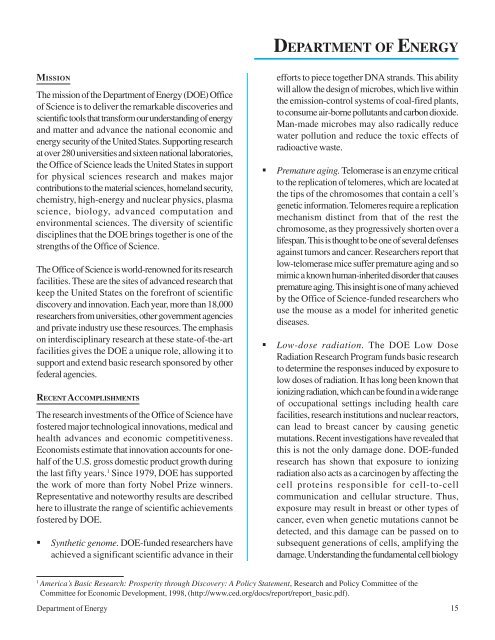national institutes of health - FASEB
national institutes of health - FASEB
national institutes of health - FASEB
Create successful ePaper yourself
Turn your PDF publications into a flip-book with our unique Google optimized e-Paper software.
DEPARTMENT OF ENERGY<br />
MISSION<br />
The mission <strong>of</strong> the Department <strong>of</strong> Energy (DOE) Office<br />
<strong>of</strong> Science is to deliver the remarkable discoveries and<br />
scientific tools that transform our understanding <strong>of</strong> energy<br />
and matter and advance the <strong>national</strong> economic and<br />
energy security <strong>of</strong> the United States. Supporting research<br />
at over 280 universities and sixteen <strong>national</strong> laboratories,<br />
the Office <strong>of</strong> Science leads the United States in support<br />
for physical sciences research and makes major<br />
contributions to the material sciences, homeland security,<br />
chemistry, high-energy and nuclear physics, plasma<br />
science, biology, advanced computation and<br />
environmental sciences. The diversity <strong>of</strong> scientific<br />
disciplines that the DOE brings together is one <strong>of</strong> the<br />
strengths <strong>of</strong> the Office <strong>of</strong> Science.<br />
The Office <strong>of</strong> Science is world-renowned for its research<br />
facilities. These are the sites <strong>of</strong> advanced research that<br />
keep the United States on the forefront <strong>of</strong> scientific<br />
discovery and innovation. Each year, more than 18,000<br />
researchers from universities, other government agencies<br />
and private industry use these resources. The emphasis<br />
on interdisciplinary research at these state-<strong>of</strong>-the-art<br />
facilities gives the DOE a unique role, allowing it to<br />
support and extend basic research sponsored by other<br />
federal agencies.<br />
RECENT ACCOMPLISHMENTS<br />
The research investments <strong>of</strong> the Office <strong>of</strong> Science have<br />
fostered major technological innovations, medical and<br />
<strong>health</strong> advances and economic competitiveness.<br />
Economists estimate that innovation accounts for onehalf<br />
<strong>of</strong> the U.S. gross domestic product growth during<br />
the last fifty years. 1 Since 1979, DOE has supported<br />
the work <strong>of</strong> more than forty Nobel Prize winners.<br />
Representative and noteworthy results are described<br />
here to illustrate the range <strong>of</strong> scientific achievements<br />
fostered by DOE.<br />
<br />
Synthetic genome. DOE-funded researchers have<br />
achieved a significant scientific advance in their<br />
<br />
<br />
efforts to piece together DNA strands. This ability<br />
will allow the design <strong>of</strong> microbes, which live within<br />
the emission-control systems <strong>of</strong> coal-fired plants,<br />
to consume air-borne pollutants and carbon dioxide.<br />
Man-made microbes may also radically reduce<br />
water pollution and reduce the toxic effects <strong>of</strong><br />
radioactive waste.<br />
Premature aging. Telomerase is an enzyme critical<br />
to the replication <strong>of</strong> telomeres, which are located at<br />
the tips <strong>of</strong> the chromosomes that contain a cell’s<br />
genetic information. Telomeres require a replication<br />
mechanism distinct from that <strong>of</strong> the rest the<br />
chromosome, as they progressively shorten over a<br />
lifespan. This is thought to be one <strong>of</strong> several defenses<br />
against tumors and cancer. Researchers report that<br />
low-telomerase mice suffer premature aging and so<br />
mimic a known human-inherited disorder that causes<br />
premature aging. This insight is one <strong>of</strong> many achieved<br />
by the Office <strong>of</strong> Science-funded researchers who<br />
use the mouse as a model for inherited genetic<br />
diseases.<br />
Low-dose radiation. The DOE Low Dose<br />
Radiation Research Program funds basic research<br />
to determine the responses induced by exposure to<br />
low doses <strong>of</strong> radiation. It has long been known that<br />
ionizing radiation, which can be found in a wide range<br />
<strong>of</strong> occupational settings including <strong>health</strong> care<br />
facilities, research institutions and nuclear reactors,<br />
can lead to breast cancer by causing genetic<br />
mutations. Recent investigations have revealed that<br />
this is not the only damage done. DOE-funded<br />
research has shown that exposure to ionizing<br />
radiation also acts as a carcinogen by affecting the<br />
cell proteins responsible for cell-to-cell<br />
communication and cellular structure. Thus,<br />
exposure may result in breast or other types <strong>of</strong><br />
cancer, even when genetic mutations cannot be<br />
detected, and this damage can be passed on to<br />
subsequent generations <strong>of</strong> cells, amplifying the<br />
damage. Understanding the fundamental cell biology<br />
1<br />
America’s Basic Research: Prosperity through Discovery: A Policy Statement, Research and Policy Committee <strong>of</strong> the<br />
Committee for Economic Development, 1998, (http://www.ced.org/docs/report/report_basic.pdf).<br />
Consensus Department Conference <strong>of</strong> Energy Report 15





